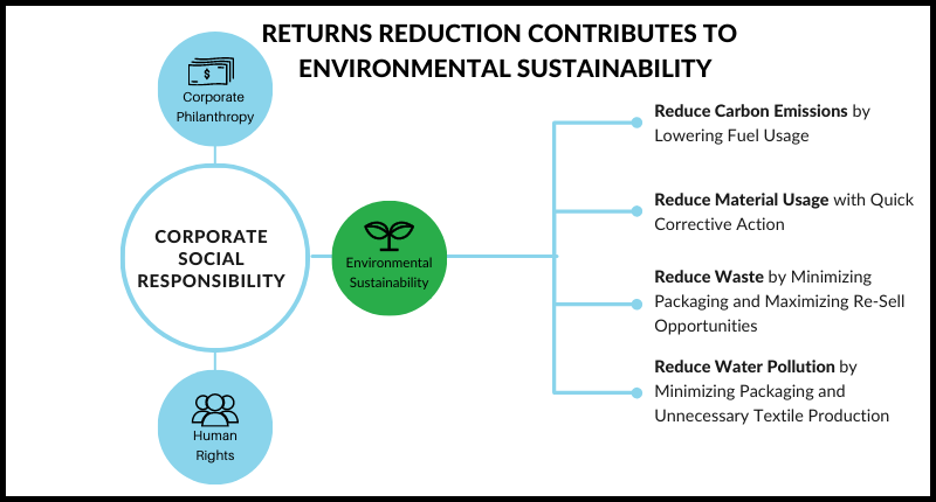The fashion industry has an enormous impact on the environment, coming only second to the oil industry in terms of pollution. Until recently, sustainability in fashion was a niche category. However, the public demand for sustainable retailing has changed. A study done by Nosto has found that 52% of consumers want the fashion industry to follow more sustainable practices; however, only 32% of consumers would pay more for a garment made from a sustainable company.
“Fashion's supply chains are so complex and opaque, that it's hard to figure out exactly how much pollution it creates.”
–Alec Leach, Future_Dust on Instagram.
With this changing sentiment, retailers need to address sustainability issues without adding significant operating costs. Many large fashion retailers are incorporating sustainability into their businesses through recycled materials or committing to donating to environmental organizations. For example, American Eagle committed to being carbon neutral by 2030 while also reducing its water usage in jean production by 30%. Nordstrom has committed to five goals in its efforts to environmental protection, including donating $1M to textile recycling. However, these actions may not be possible for all retailers, as many are struggling with profitability and maintaining a healthy bottom line. Therefore, they need to start looking at opportunities to lower their environmental impact that result in cost savings, rather than an expense.
How does returns reduction impact sustainability?
This is where returns reduction comes in. Product returns having been growing for the past few years, and the shift from brick-and-mortar shopping to e-commerce exacerbated by COVID-19 has precipitated the increase in return volume. Furthermore, e-commerce return rates are 2 to 3 times higher than returns that occur from in-store transactions.
This growth results in an immense and negative environmental impact. When retailers reduce their returns, they can improve their impact on the environment in various aspects: landfill, carbon emissions, package pollution, and wasted textiles, to name a few. Additionally, returns reduction can improve retailers’ bottom lines and keep their customers happy.

Landfill
Every year, 5 billion pounds of returned goods end up in landfills in the United States. This can be attributed to multiple reasons, such as quality issues, product damage or the product simply no longer being in-season. And with the significant cost of shuffling products back and forth falling on the retailer, the cost of remarketing returned goods is often more expensive than disposal. Returns reduction lowers the number of products coming back, thus reducing the number of goods being too late for re-sell. Another way to remedy this problem is having clear visibility of the product location after the customer has initiated a return. A tight supply chain allows for retailers to plan for re-sell opportunities. Newmine's Advanced Returns Insights provides retailers with visibility into their returned goods at every stage.
Carbon Emissions
The typical journey of a returned good can amount to 1,200 miles in length, resulting in the production of 15 million metrics tons of carbon emissions annually. Returns reduction ensures that there are fewer errors in the supply chain and fewer returns overall, thus lowering the carbon footprint from packages traveling back and forth from their destination and the DC. Another consideration is the inverse of last mile delivery: “first mile returns” will add emissions as more retailers offer free doorstep pickup of returns.
Packaging
In 2019, it has been estimated that Amazon generated 465 million pounds of plastic packaging. 22.44 million pounds of this plastic ended up polluting freshwater and marine ecosystems. This is equivalent to dumping a delivery van’s worth of plastic into water ecosystems every 70 minutes. When goods are resold or extra goods are sent to customers in lieu of returns, there is an increase in packaging, which could have been avoided with returns reduction.
Wasted Textiles
About 20% of the world’s industrial water pollution can be attributed to garment manufacturing. Quick problem detection allows for quick corrective action, so there is less wasted material. For example, if thousands of shirts are cut with the wrong neckline, this problem can be detected and remedied before cutting more copies, wasting the fabric and contributing to unnecessary water pollution. Big data in Returns Reduction leads to directional feedback and smarter inventory projections, so retailers can ultimately learn how to put together better product assortments that will not need to be disposed of or wasted.
Globally, retailers produce 80 billion garments each year, and about 20% of those are never sold, and of those sold online, retailers can expect 15% to over 30% of those goods returned. This highlights the disconnect between what is being produced and what customers want.
It’s no longer an option for retailers not to have a sustainable mission incorporated into their business. With returns reduction, retailers can lower the environmental impact of their business without damaging their bottom line.
Newmine's Chief Returns Officer can minimize this gap with comprehensive customer purchase and returns data. The incorporation of the voice of the customer allows for retailers to better understand what their customers are looking for and how to provide the best images/details to give them more confidence in the item they are purchasing. Managing inventory with this information creates less waste, less unnecessary packaging, less carbon emissions and improves retailer’s bottom line.
For more on how retailers are using returns technology to have positive environmental impact, watch the Coresight Webinar Replay.
